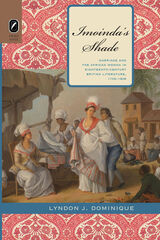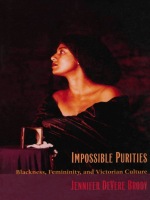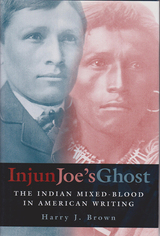115 books about Race in literature and 3
start with I
115 books about Race in literature and 3
115 books about Race in literature
3 start with I start with I
3 start with I start with I

Imoinda’s Shade
Marriage and the African Woman in Eighteenth-Century British Literature, 1759–1808
Lyndon J. Dominique
The Ohio State University Press, 2012
As the eighteenth century is entirely bereft of narratives written by African women, one might assume that these women had little to no impact on British literature and the national psyche of the period. Yet these kinds of assumptions are belied by the influence of one prominent African woman featured in the period’s literary texts.
Imoinda’s Shade examines the ways in which British writers utilize the most popular African female figure in eighteenth-century fiction and drama to foreground the African woman’s concerns and interests as well as those of a British nation grappling with the problems of slavery and abolition. Imoinda, the fictional phenomenon initially conceived by Aphra Behn and subsequently popularized by Thomas Southerne, has an influence that extends well beyond the Oroonoko novella and drama that established her as a formidable presence during the late Restoration period. This influence is palpably discerned in the characterizations of African women drawn up in novels and dramas written by late-eighteenth-century British writers. Through its examinations of the textual instances from 1759–1808 when Imoinda and her involvement in the Oroonoko marriage plot are being transformed and embellished for politicized ends, Imoinda’s Shade demonstrates how this period’s fictional African women were deliberately constructed by progressive eighteenth-century writers to popularize issues of rape, gynecological rebellion, and miscegenation. Moreover, it shows how these specific African female concerns influence British antislavery, abolitionist, and post-slavery discourse in heretofore unheralded, unusual, and sometimes radical ways.
[more]

Impossible Purities
Blackness, Femininity, and Victorian Culture
Jennifer DeVere Brody
Duke University Press, 1998
Using black feminist theory and African American studies to read Victorian culture, Impossible Purities looks at the construction of “Englishness” as white, masculine, and pure and “Americanness” as black, feminine, and impure. Brody’s readings of Victorian novels, plays, paintings, and science fiction reveal the impossibility of purity and the inevitability of hybridity in representations of ethnicity, sexuality, gender, and race. She amasses a considerable amount of evidence to show that Victorian culture was bound inextricably to various forms and figures of blackness.
Opening with a reading of Daniel Defoe’s “A True-Born Englishman,” which posits the mixed origins of English identity, Brody goes on to analyze mulattas typified by Rhoda Swartz in William Thackeray’s Vanity Fair, whose mixed-race status reveals the “unseemly origins of English imperial power.” Examining Victorian stage productions from blackface minstrel shows to performances of The Octoroon and Uncle Tom’s Cabin, she explains how such productions depended upon feminized, “black” figures in order to reproduce Englishmen as masculine white subjects. She also discusses H.G. Wells’s The Island of Dr. Moreau in the context of debates about the “new woman,” slavery, and fears of the monstrous degeneration of English gentleman. Impossible Purities concludes with a discussion of Bram Stoker’s novella, “The Lair of the White Worm,” which brings together the book’s concerns with changing racial representations on both sides of the Atlantic.
This book will be of interest to scholars in Victorian studies, literary theory, African American studies, and cultural criticism.
Opening with a reading of Daniel Defoe’s “A True-Born Englishman,” which posits the mixed origins of English identity, Brody goes on to analyze mulattas typified by Rhoda Swartz in William Thackeray’s Vanity Fair, whose mixed-race status reveals the “unseemly origins of English imperial power.” Examining Victorian stage productions from blackface minstrel shows to performances of The Octoroon and Uncle Tom’s Cabin, she explains how such productions depended upon feminized, “black” figures in order to reproduce Englishmen as masculine white subjects. She also discusses H.G. Wells’s The Island of Dr. Moreau in the context of debates about the “new woman,” slavery, and fears of the monstrous degeneration of English gentleman. Impossible Purities concludes with a discussion of Bram Stoker’s novella, “The Lair of the White Worm,” which brings together the book’s concerns with changing racial representations on both sides of the Atlantic.
This book will be of interest to scholars in Victorian studies, literary theory, African American studies, and cultural criticism.
[more]

Injun Joe's Ghost
The Indian Mixed-Blood in American Writing
Harry J. Brown
University of Missouri Press, 2004
What does it mean to be a “mixed-blood,” and how has our understanding of this term changed over the last two centuries? What processes have shaped American thinking on racial blending? Why has the figure of the mixed-blood, thought too offensive for polite conversation in the nineteenth century, become a major representative of twentieth-century native consciousness?
In Injun Joe’s Ghost, Harry J. Brown addresses these questions within the interrelated contexts of anthropology, U.S. Indian policy, and popular fiction by white and mixed-blood writers, mapping the evolution of “hybridity” from a biological to a cultural category. Brown traces the processes that once mandated the mixed-blood’s exile as a grotesque or criminal outcast and that have recently brought about his ascendance as a cultural hero in contemporary Native American writing.
Because the myth of the demise of the Indian and the ascendance of the Anglo-Saxon is traditionally tied to America’s national idea, nationalist literature depicts Indian-white hybrids in images of degeneracy, atavism, madness, and even criminality. A competing tradition of popular writing, however, often created by mixed-blood writers themselves, contests these images of the outcast half-breed by envisioning “hybrid vigor,” both biologically and linguistically, as a model for a culturally heterogeneous nation.
Injun Joe’s Ghost focuses on a significant figure in American history and culture that has, until now, remained on the periphery of academic discourse. Brown offers an in-depth discussion of many texts, including dime novels and Depression-era magazine fiction, that have been almost entirely neglected by scholars. This volume also covers texts such as the historical romances of the 1820s and the novels of the twentieth-century “Native American Renaissance” from a fresh perspective. Investigating a broad range of genres and subject over two hundred year of American writing, Injun Joe’s Ghost will be useful to students and professionals in the fields of American literature, popular culture, and native studies.
[more]
READERS
Browse our collection.
PUBLISHERS
See BiblioVault's publisher services.
STUDENT SERVICES
Files for college accessibility offices.
UChicago Accessibility Resources
home | accessibility | search | about | contact us
BiblioVault ® 2001 - 2024
The University of Chicago Press









